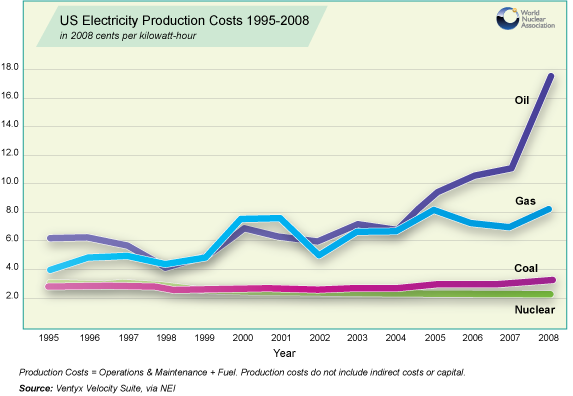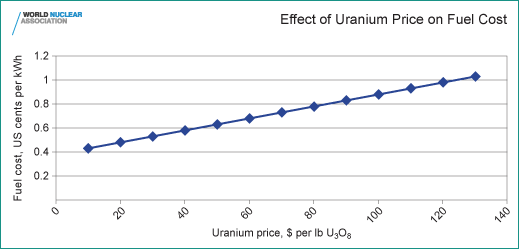International
collaboration to improve safety

There is a great deal of
international cooperation on nuclear safety issues, in particular the exchange
of operating experience under the auspices of the World Association of Nuclear
Operators (WANO) which was set up in 1989. In practical terms this is the
most effective international means of achieving very high levels of safety
through its four major programs: peer reviews; operating experience; technical
support and exchange; and professional and technical development. WANO peer
reviews are the main proactive way of sharing experience and expertise, and by
the end of 2009 every one of the world's commercial nuclear power plants had
been peer-reviewed at least once. Following the Fukushima accident these
have been stepped up to one every four years at each plant, with follow-up
visits in between, and the scope extended from operational safety to include
plant design upgrades. Pre-startup reviews of new plants are being increased.
See also: paper on Cooperation in Nuclear Power Industry.
The IAEA Convention
on Nuclear Safety (CNS) was drawn up
during a series of expert level meetings from 1992 to 1994 and was the result
of considerable work by Governments, national nuclear safety authorities and
the IAEA Secretariat. Its aim is to legally commit participating States
operating land-based nuclear power plants to maintain a high level of safety by
setting international benchmarks to which States would subscribe.
The obligations of the Parties are
based to a large extent on the principles contained in the IAEA Safety
Fundamentals document The Safety of Nuclear Installations. These
obligations cover for instance, siting, design, construction, operation, the
availability of adequate financial and human resources, the assessment and
verification of safety, quality assurance and emergency preparedness.
The Convention is an incentive
instrument. It is not designed to ensure fulfillment of obligations by Parties
through control and sanction, but is based on their common interest to achieve
higher levels of safety. These levels are defined by international benchmarks developed
and promoted through regular meetings of the Parties. The Convention obliges
Parties to report on the implementation of their obligations for international
peer review. This mechanism is the main innovative and dynamic element of
the Convention. Under the Operational Safety Review Team (OSART) program
dating from 1982 international teams of experts conduct in-depth reviews of
operational safety performance at a nuclear power plant. They review emergency
planning, safety culture, radiation protection, and other areas. OSART missions
are on request from the government, and involve staff from regulators, in these
respects differing from WANO peer reviews.
The Convention entered into force in
October 1996. As of September 2009, there were 79 signatories to the
Convention, 66 of which are contracting parties, including all countries with
operating nuclear power plants.
The IAEA General Conference
unanimously endorsed the Action Plan on Nuclear Safety that Ministers requested
in June. The plan arises from intensive consultations with Member States but
not with industry, and is described as both a rallying point and a blueprint
for strengthening nuclear safety worldwide. It contains suggestions to make
nuclear safety more robust and effective than before, without removing the
responsibility from national bodies and governments. It aims to ensure
"adequate responses based on scientific knowledge and full
transparency". Apart from strengthened and more frequent IAEA peer reviews
(including those of regulatory systems), most of the 12 recommended actions are
to be undertaken by individual countries and are likely to be well in hand
already.
In relation to Eastern Europe
particularly, since the late 1980s a major international program of assistance
was carried out by the OECD, IAEA and Commission of the European Communities to
bring early Soviet-designed reactors up to near western safety standards, or at
least to effect significant improvements to the plants and their operation. The
European Union also brought pressure to bear, particularly in countries which
aspired to EU membership.
Modifications were made to overcome
deficiencies in the 11 RBMK reactors still
operating in Russia. Among other things, these removed the danger of a positive
void coefficient response. Automated inspection equipment has also been
installed in these reactors.
The other class of reactors which
has been the focus of international attention for safety upgrades is the
first-generation of pressurised water VVER-440 reactors. The V-230 model was
designed before formal safety standards were issued in the Soviet Union and
they lack many basic safety features. Four are still operating in Russia and
one in Armenia, under close inspection.
Later Soviet-designed reactors are
very much safer and have Western control systems or the equivalent, along with
containment structures.
Sources : Safety of Nuclear Power Reactors, from website http://www.world-nuclear.org/info/inf06.html
























